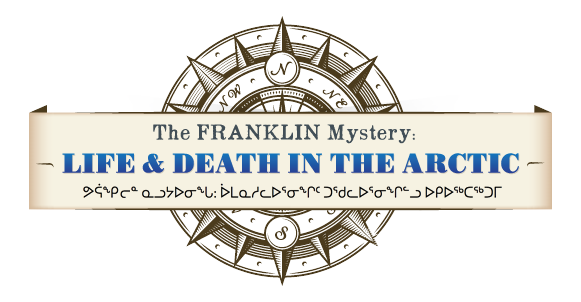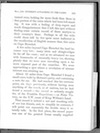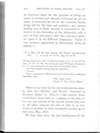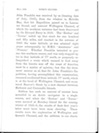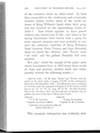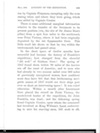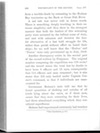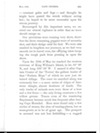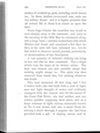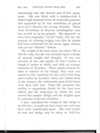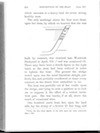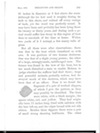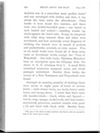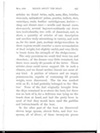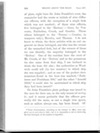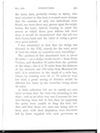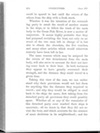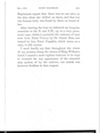McClintock reports finding the Cairn and Bodies (1860)
About 12 miles from Cape Herschel I found a small cairn built by Hobson's party, and containing a note for me. He had reached this his extreme point, six days previously, without having seen anything of the wreck, or of natives, but he had found a record - the record so ardently sought for, of the Franklin Expedition - at Point Victory, on the N.W. coast of King William's Land.
That record is indeed a sad and touching relic of our lost friends, and, to simplify its contents, I will point out separately the double story it so briefly tells. In the first place, the record paper was one of the printed forms usually supplied to discovery ships for the purpose of being enclosed in bottles and thrown overboard at sea, in order to ascertain the set of the currents, blanks being left for the date and position ; any person finding one of these records is requested to forward it to the Secretary of the Admiralty, with a note of time and place ; and this request is printed upon it in six different languages. Upon it was written, apparently by Lieutenant Gore, as follows:-
"28 of May, 1847 { H.M. ships 'Erebus' and 'Terror' wintered in the ice in lat. 70˚ 05' N ; long. 98˚ 23' W.
Having wintered in 1846-7 at Beechey Island, in lat. 74˚ 43' 28" N., long. 91˚ 39' 15" W., after having ascended Wellington Channel to lat. 77˚, and returned by the west side of Cornwallis Island.
"Sir John Franklin commanding the expedition.
"All well.
"Party consisting of 2 officers and 6 men left the ships on Monday 24th May, 1847.
"GM. GORE, Lieut.
"CHAS. F. DES VOEUX, Mate."
There is an error in the above document, namely, that the 'Erebus' and 'Terror' wintered at Beechey Island in 1846-7,- the correct dates should have been 1845-6 ; a glance at the date at the top and bottom of the record proves this, but in all other respects the tale is told in as few words as possible of their wonderful success up to that date, May, 1847.
[ … ]
In 1846 they proceeded to the south-west, and eventually reached within twelve miles of the north extreme of King William's Land, when their progress was arrested by the approaching winter of 1846-7. That winter appears to have passed without any serious loss of life ; and when in the spring Lieutenant Gore leaves with a party for some especial purpose, and very probably to connect the unknown coast-line of King William's Land between Point Victory and Cape Herschel, those on board the 'Erebus' and 'Terror' were "all well," and the gallant Franklin still commanded.
But, alas! Round the margin of the paper upon which Lieutenant Gore in 1847 wrote those words of hope and promise, another hand had subsequently written the following words:-
"April 25, 1848 - H.M. ships 'Terror' and 'Erebus' were deserted on the 22nd April, 5 leagues N.N.W. of this, having been beset since 12th September, 1846. The officers and crews, consisting of 105 souls, under the command of Captain F.R.M. Crozier, landed here in lat. 69˚ 37' 42" N., long. 98˚ 41' W. Sir John Franklin died on the 11th June, 1847 ; and the total loss by deaths in the expedition has been to this date 9 officers and 15 men.
(Signed)
"JAMES FITZJAMES,
"Captain H.M.S. Erebus.
(Signed)
"F.R.M. CROZIER,
"Captain and Senior Officer.
"and start (on) to-morrow, 26th, for Back's Fish River."
This marginal information was evidently written by Captain Fitzjames, excepting only the note stating when and where they were going, which was added by Captain Crozier.
There is some additional marginal information relative to the transfer of the document to its present position (viz., the site of Sir James Ross's pillar) from a spot four miles to the northward, near Point Victory, where it had been originally deposited by the late Commander Gore. This little word late shows us that he too, within the twelvemonth had passed away.
In the short space of twelve months how mournful had become the history of Franklin's expedition; how changed from the cheerful "All well" of Graham Gore! The spring of 1847 found them within 90 miles of the known sea off the coast of America ; and to men who had already in two seasons sailed over 500 miles of previously unexplored waters, how confident must they have felt that that forthcoming navigable season of 1847 would see their ships pass over so short an intervening space! It was ruled otherwise. Within a month after Lieutenant Gore placed the record on Point Victory, the much-loved leader of the expedition, Sir John Franklin, was dead ; and the following spring found Captain Crozier, upon whom the command had devolved at King William's Land, endeavoring to save his starving men, 105 souls in all, from a terrible death by retreating to the Hudson Bay territories up the Back or Great Fish River.
A sad tale was never told in fewer words. There is something deeply touching in their extreme simplicity, and they show in the strongest manner that both the leaders of this retreating party were actuated by the loftiest sense of duty, and met with calmness and decision the fearful alternative of a last bold struggle for life, rather than perish without effort on board their ships ; for we well know that the 'Erebus' and 'Terror' were only provisioned up to July, 1848.
Another discrepancy exists in the second part of the record written by Fitzjames. The original number composing the expedition was 138 souls, and the record states the total loss by deaths to have been 9 officers and 15 men, consequently that 114 officers and men remained ; but it also states that 105 only landed under Captain Crozier's command, so that 9 individuals are unaccounted for.
Lieutenant Hobson's note told me that he found quantities of clothing and articles of all kinds lying about the cairn, as if these men, aware they were retreating for their lives, had there abandoned everything which they considered superfluous.
[ … ]
From Cape Crozier the coast-line was found to turn sharply away to the eastward ; and early in the morning of the 30th May we encamped alongside a large boat – another melancholy relic which Hobson had found and examined a few days before, as his note left here informed me ; but he had failed to discover record, journal, pocketbook, or memorandum of any description.
A vast quantity of tattered clothing was lying in her, and this we first examined. Not a single article bore the name of its former owner. The boat was cleared out and carefully swept that nothing might escape us. The snow was then removed from about her, but nothing whatever was found.
This boat measured 28 feet long, and 7 feet 3 inches wide ; she was built with a view to lightness and light draught of water, and evidently equipped with the utmost care for the ascent of the Great Fish River ; she had neither oars nor rudder, paddles supplying their place, and as a large remnant of light canvas, commonly known as No. 8, was found, and also a small block for reeving a sheet through, I suppose she had been provided with a sail. A sloping canvas roof or rain-awning had also formed part of her equipment. She was fitted with a weather-cloth 9 inches high, battened down all round the gunwale, and supported by 24 iron stanchions, so place as to serve likewise for rowing thowells. There were 50 fathoms of deep-sea sounding-line near her, as well as an ice grapnel. She appeared to have been originally "carvel" built ; but for the purpose of reducing weight, very thin fir planks had been substituted for her seven upper strakes, and put on "clincher" fashion.
[ … ]
But all these were after observations ; there was that in the boat which transfixed us with awe. It was portions of two human skeletons. One was that of a slight young person ; the other of a large, strongly-made, middle-aged man. The former was found in the bow of the boat, but in too much disturbed a state to enable Hobson to judge whether the sufferer had died there ; large and powerful animals, probably wolves, had destroyed much of this skeleton, which may have been that of an officer. Near it we found the fragment of a pair of worked slippers, of which I give the pattern, as they may possibly be identified. The lines were white, with a black margin ; the spaces white, red, and yellow. They had originally been 11 inches long, lined with calf-skin with the hair left on, and the edges bound with red silk ribbon. Besides these slippers there were a pair of small strong shooting half-boots. The other skeleton was in a somewhat more perfect state, * and was enveloped with clothes and furs ; it lay across the boat, under the after-thwart. Close beside it were found five watches ; and there were two double-barrelled guns – one barrel in each loaded and cocked – standing muzzle upwards against the boat's side. It may be imagined with what deep interest these sad relics were scrutinised, and how anxiously every fragment of clothing was turned over in search of pockets and pocketbooks, journals, or even names. Five or six small books were found, all of them scriptural or devotional works, except the 'Vicar of Wakefield.' One little book, 'Christian Melodies,' bore an inscription upon the titlepage from the donor to G.G. (Graham Gore?) A small Bible contained numerous marginal notes, and whole passages underlined. Besides these books, the covers of a New Testament and Prayerbook were found.
Amongst an amazing quantity of clothing there were seven or eight pairs of boots of various kinds – cloth winter boots, sea boots, heavy ankle boots, and strong shoes. I noted that there were silk handkerchiefs – black, white, and figured – towels, soap, sponge, tooth-brush, and hair-combs ; mackintosh gun-cover, marked outside with paint A 12 and lined with black cloth.
[ … ]
The only provisions we could find were tea and chocolate ; of the former very little remained, but there were nearly 40 pounds of the latter. These articles alone could never support life in such a climate, and we found neither biscuit nor meat of any kind.
[ … ]
I was astonished to find that the sledge was directed to the N.E., exactly for the next point of land for which we ourselves were travelling!
The position of this abandoned boat is about 50 miles – as a sledge would travel – from Point Victory, and therefore 65 miles from the position of the ships ; also it is 70 miles from the skeleton of the steward, and 150 miles from Montreal Island ; it is moreover in the depths of a wide bay, where, by crossing over 10 or 12 miles of very low land, a great saving of distance would be effected, the route by the coast-line being about 40 miles.
A little reflection led me to satisfy my own mind at least, that the boat was returning to the ships ; and in no other way can I account for two men having been left in her, than by supposing the party were unable to drag the boat further, and that these two men, not being able to keep pace with their shipmates, were therefore left by them supplied with such provisions as could be spared to last until the return of the others from the ship with a fresh stock.
Whether it was the intention of the retroceding party to await the result of another season in the ships, or to follow the track of the main body to the Great Fish River, is now a matter of conjecture. It seems highly probable that they had purposed revisiting the boat, not only on account of the two men left in charge of it, but also to obtain the chocolate, the five watches, and many other articles which would otherwise scarcely have been left in her.
The same reasons which may be assigned for the return of this detachment from the main body, will also serve to account for their not having come back to their boat. In both instances they appear to have greatly overrated their strength, and the distance they could travel in a given time.
Taking this view of the case, we can understand why their provisions would not last them for anything like the distance they required to travel ; and why they would be obliged to send back to the ships for more, first taking from the detached party all provisions they could possibly spare. Whether all or any of the remainder of this detached party ever reached their ships is uncertain ; all we know is, that they did not revisit the boat, and which accounts for the absence of more skeletons in its neighbourhood ; and the Esquimaux report that there was no one alive in the ship when she drifted on shore, and that but one human body was found by them on board of her.
* No part of the skull of either skeleton was found, with the exception only of the lower jaw of each.

